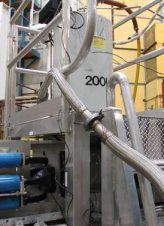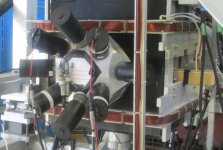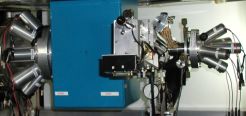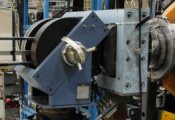

A μSR spectrometer is a magnet (or magnets) plus an array of counters to detect incoming muons and decay positrons.
The magnets are of various types - Helmholtz, solenoid, or solid pole electromagnet; superconducting or not. In fact, most spectrometers have more than one magnet. The main magnet of an apparatus is usually oriented so the field is along the beam axis (z direction) which allows surface muons to enter the sample without being turned away. Other coils provide weaker fields in perpendicular directions either for zeroing the field or for applying weak fields (<10 mT) transverse (x,y directions) to the beam direction.
Most of the counter systems are movable in various ways, and many follow a uniform standard design of multi-counter modules mounted on tracks on tables attached to the spectrometer. Some counter arrangements are partially built into the sample inserts. These are the low background apparatuses for small or thin samples which have veto counters to reject counts from anything but the sample itself.
All apparatuses rest, and roll, on standardized rails so they can be reproducibly positioned in any beamline. They can be rolled back from the beam snout (to access collimators etc) at any time and accurately rolled back into position by one person. The four beam lines, M15, M20, M9B and M13 which are used for µSR have such rail systems.
| Magnet Type: | Superconducting solenoid |  | ||
| Field Strength/Orientation: | 5.5 T / z, and 2 mT / y | |||
| Field Calibration: | 0.096233 T/A | |||
| Counter acceptance: | 1-3 π | |||
| Experiment types: | LF, TF, HTF, RF-microwave | |||
| Thermometry | ||||
|
| ||||
| Magnet Type: | Superconducting Helmholtz |  | ||
| Field Strength/Orientation: | 5 T / z, 2.5 mT / x | |||
| Field Calibration: | 0.0617 T/A | |||
| Counter acceptance: | 0.1-1.5 π | |||
| Experiment types: | LF, TF, ZF, HTF | |||
| Thermometry | ||||
| Magnet Type: | Superconducting Solenoid |  | ||
| Field Strength/Orientation: | 7.0 T / z | |||
| Field Calibration: | 0.09950 T/A | |||
| Counter acceptance: | 3 π | |||
| Experiment types: | HTF, HLF | |||
| Thermometry | ||||
| Magnet Type: | Solid Pole Electromagnet |  | ||
| Field Strength/Orientation: | 0.3 T / x | |||
| Counter acceptance: | 1 π | |||
| Experiment types: | TF |
| Magnet Type: | LF/TF Helmholtz |  | ||
| Field Strength/Orientation: | 33 mT / z, y | |||
| Counter acceptance: | 1-2 π, x-direction | |||
| Experiment types: | TF, LTF, ZF |
| Magnet Type: | Superconducting Split Pair |  | ||
| Field Strength/Orientation: | 7.0 T / z | |||
| Field Calibration: | 0.09068 T/A | |||
| Counter acceptance: | 3 π | |||
| Experiment types: | HTF, HLF | |||
| Thermometry | ||||
| Magnet Type: | Superconducting Helmholtz |  | ||
| Field Strength/Orientation: | 7.5 T / z | |||
| Field Calibration: | 0.0747 T/A | |||
| Counter acceptance: | 3 π | |||
| Experiment types: | HTF |
| Magnet Type: | Solid Pole Electromagnet |  | ||
| Field Strength/Orientation: | 1 T / x | |||
| Counter acceptance: | 1-2 π | |||
| Experiment types: | TF with high momentum muons |
| Magnet Type: | 3 x Helmholtz |  | ||
| Field Strength/Orientation: | 0.3 T / z, and 20 mT / x, y | |||
| Field Calibration: | 0.0004 T/A (4 G/A) | |||
| Counter acceptance: | 4 π | |||
| Experiment types: | LF, TF, LTF, ZF, RF-microwave |
| LF = | Longitudinal Field. | |
| ZF = | Zero Field (with a flux gate magnetometer and ZF controller available). | |
| TF = | Transverse Field (usually requiring spin rotation). | |
| LTF = | Low Transverse Field (without spin rotation, <10 mT). | |
| HTF = | High Transverse Field (spin rotation and fast-timing counters and perhaps with feedback field control). | |
| RF = | Radio Frequency. | |
| z = | The beam direction | |
| x = | Up (perpendicular to beam - the spin direction of spin-rotated surface muons ) | |
| y = | Right (perpendicular to beam - the spin direction of spin-rotated muons in M9b) |